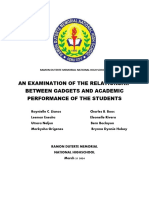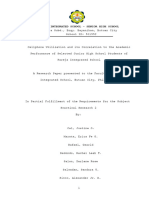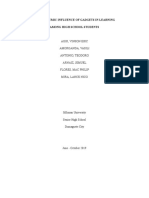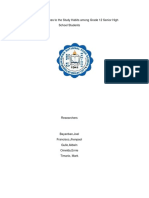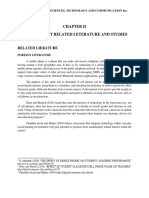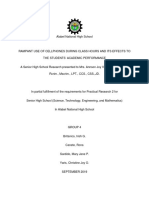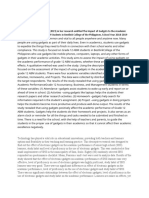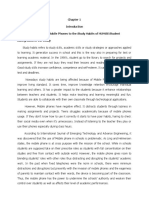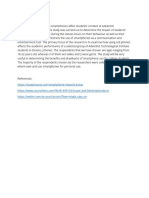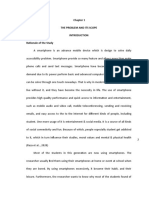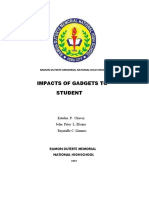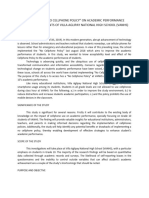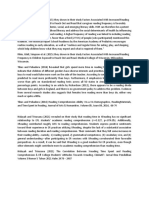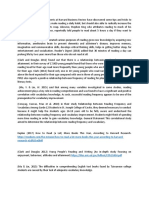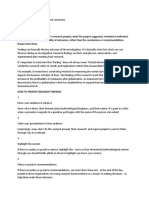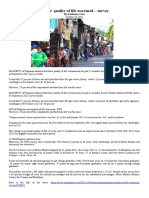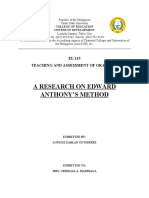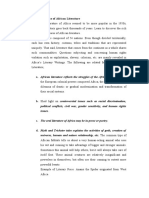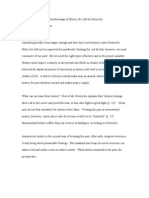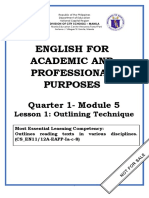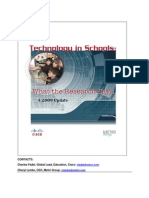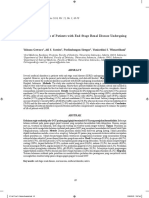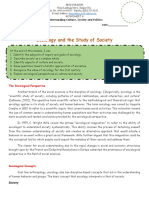“THE EFFECT OF “NO CELLPHONE POLICY” ON ACADEMIC
PERFORMANCE OF GRADE-10 STUDENTS OF VILLA
AGLIPAY NATIONAL HIGH SCHOOL (VANHS)”
INTRODUCTION
(MENDEZ AND BALAGTAS, 2019). In this modern generation, abrupt advancement of
technology is observed. School administrators and teachers noticed that students nowadays, use
cellular phones for leisure rather than for emergency and educational purposes. In view of this
prevailing issue, the school implemented the “No Cellphone Policy” last august 2018 which aims
to improve the academic performance of students. In this study, we wanted to know acceptability
level and effect of No Cellphone Policy to the academic performance of students.
Technology is advancing quickly, and the ubiquitous use of cellphones, in particular, has
transformed communication and information accessibility. Concerns regarding the influence of
this technological change on students academic performance have been voiced, nevertheless. To
address these issue, schools all across the world have started implementing “No Cellphone
Policy” in schools. The purpose of this study is to access hos a “No Cellphone Policy” at
VANHS affects students in Grade 10’s academic performance.
Like many educational institutions, Villa Aglipay National High Schools struggles to
control smartphone usage among its students. Students in all grade levels are not allowed to use
cellphones during class hour at VANHS: for the following; a.) in order to improve the study
environment; b.) to reduce distractions and increase students academic participation; c.) and this
policy prohibits the use of mobile devices in the classroom.
SIGNIFICANCE OF THE STUDY
This study is significant for several reasons. Firstly it will contribute to the existing body
of knowledge on the impact of cellphone use on academic performance, specially focusing on
Grade 10 students of VANHS. The finding will provide valuable insights for educational
institutions, administrators, teachers, and parents in making informed decisions regarding the
implementation of cellphones policies. Additionally, the study will help identify any potential
benefits or drawbacks of implementing a no cellphone policy, thereby enabling development of
effective strategies to enhance student’s academic performance.
SCOPE OF THE STUDY
This investigation will take place at Villa Aglipay National High School (VANHS), with
a particular emphasis on students in Grade 10. The majority of the research findings will be
based on quantitative data collected through academic records and surveys. The likelihood of
self-reporting biases in the questionnaires and the inability to control outside variables that can
affect student’s academic achievement are a couple of the study’s shortcomings that should be
noted.
�PURPOSE AND OBJECTIVE
Its goal is to determine how the no-cellphone rule at Villa Aglipay National High School
(VANHS) affects the academic performance of Grade 10 students. The goal is to determine
whether preventing smartphone use in the classroom has favorable affect on student
involvement, focus, and learning results as a whole. This study aims to offer important insights
into the potential advantages of restricting cellphone use during class time, ultimately adding to
the ongoing discussion on effective strategies for boosting student learning and achievement in
secondary education settings. This is done by comparing the academic performance of students
before and after the policy was put into place.
REVIEW OF RELATED LITERATURE
FOREIGN LITERATURE
(Beland, 2021), stated on his study titled Banning Mobile Phone in Schools Can Improve
Students’ Academic Performance, that banning of mobile phones at school leads to an increase
in students performance. Our results suggest that after schools ban mobile phones, test scores of
students aged 16 increased by 6.4% of a standard deviation. This is equivalent to adding five
days to the school year or an additional hour a week. He also added that the effects were twice as
large for low achieving students, and they found no impact on high achieving students.
(MURPHY, 2016), this paper investigates the impact of schools banning mobile phones
on students test scores. By surveying schools in four English cities regarding their mobile phone
policies and combining it with administrative data, we adopt a difference in differences (DID)
strategy, exploiting variations in schools’ autonomous decisions to ban these devices,
conditioning on a range of student characteristics and prior achievement. We find that student
performance in high stakes exams significantly increases post ban, by about 0.07 standard
deviations on average. These increases in performance are driven by the lowest achieving
students. This suggest that the unstructured presence of phones has detrimental effects on certain
students and restricting their use can be low-cost policy to reduce educational inequalities.
Soyemi Jumoke, et. al.(2015), emphasizes on the usage of the internet on Mobile Phones.
This research was conducted to find the correlation between the academic performance and
usage of Mobile Phones by the students of Ogun state in Nigeria. The findings indicated that
students are influenced negatively to a great extent by the Mobile Phone because attention is
focused on chatting, music and others while their academic activities are neglected and left to
suffer.
(THE EDUCATOR, 2021), throughout 2020, public school students in South Australia,
Western Australia, Victoria and Tasmania were instructed not to bring their mobile phones to
class, unless the are needed for class activity. NSW also banned smart phones in public primary
schools but had given secondary students the option to bring phones to class since the start of last
year.
�LOCAL LITERATURE
(MENDEZ AND BALAGTAS, 2019), respondents perceived the highest acceptability
level with an average weighted mean of 2.25 on No Cellphone Policy in terms of socialization.
Respondents also agreed on No Cellphone Policy in terms of academic performance and health
with 2.17 and 2.11 average weighted means, respectively. From the 76 respondents, 37 or
48.68% increased, 15 or 19.74% retained and 24 or 31.58% decreased in academic performance
during the second quarter. The study found that there is a significant difference between the
academic performance of the students during the first quarter without No Cellphone Policy and
second quarter with No Cellphone Policy. It was also found that most of the students’ general
weighted average during the second quarter is higher that the first quarter.
Managyo (2017), stated the, Filipinos are using their mobile phones not only to
communicate but also as mobile computers as well, according to a recent market study issued.
TNS, a global customized research company, said in its report that Filipino consumers are not
must using cellphones to call and texting messages and photos, but also as a means to have
internet on-the-go, allowing users to be always online. Of the 38,000 respondents in Metro
Manila, 75 percent of the respondents surveyed used mobile phones to take photos or videos; 44
percent to access their social networking sites and 37 percent to check their emails.
REVIEW OF RELATED STUDIES
FOREIGN STUDIES
Kessel, Dany Lif Hardardottir, Hulda Tyrefors, Bjorn (2019) Recently, policy makers
worldwide have suggested and passed legislation to ban mobile phone use in schools. The
influential and only quantitative evaluation by Beland and Murphy (2016), suggests that this is a
very low-cost but effective policy to improve students performance. In particular, it suggests that
the lowest-achieving students have the most to gain.
(KIEMA, 2015) Proponents of banning cellphones in schools believed the potential
benefits of cellphones are outweighed by concerns of negatively impacted student learning,
cheating, cyberbullying, sexting and the distraction posed to teachers and students.
CONCLUSION
The analysis of the survey data provided insightful information regarding to The Effect of
No Cellphone Policy on Academic Performance of Grade 10 Students in Villa Aglipay National
High School (VANHS). Based on the findings of the study, 14 out of 25 respondents answered
“Yes, Significantly” that the No Cellphone Policy has had positive impact in their Academic
Performance, while 6 out of 25 respondents answered “Yes, to some extent”, and 3 out of 25
answered “No, not really”, and 2 out of 25 respondents answered “Not sure” to the question
�(Overall, do you believe that the “No Cellphone Policy” has had positive impact on your
academic performance?). The researchers found out that there is a significant relationship
between No Cellphone Policy to the academic performance of Grade 10 students. Based on the
survey, the No Cellphone Policy has an positive impact to the academic performance of grade 10
students. Some of the respondents answers to the survey that the no cellphone policy will
improve their performance because they will think deeper without the use of cellphone during
class.
REFFERENCE
Beland (2021) Banning Mobile Phones in Schools can Improve Students’ Academic
performance
https://phys.org/news/2021-03-mobile-schools-students-academic.html
Beland and Murphy (2016) III Communication: Technology & Student Performance
https://www.sciencedirect.com/science/article/abs/pii/S09275116300136
Kiema (2015) As Schools Lift Bans on Cell Phones, Educators Weigh Pros and Cons
Kessel, Dany Lif Hardardottir, Hulda Tyrefors, Bjorn (2019) The impact of banning mobile
phones in Swedish Secondary schools
Managyo (2017) Negative Effects of Cellular Phone in Academic Performance of Junior High
School Students in St. Gregory College Of Valenzuela
Mendez and Balagtas (2017) No Cellphone Policy: Impact to the academic Performance of
Grade 11 in Bolo Norte High School
The Educator (2021) The evidence is clear: Students learn better without mobile phones in class
https://www.theeducatoronline.com/k12/news/the-evidence-is-clear-students-learn-better-
without-mobile-phones-in-class/276071
Soyemi Jumoke (2015) Analysis of Mobile Phone Impact on Student Academic Performance in
Tertiary Institution
https://api.semanticscholar.org/CorpusID:212449593?utm_source=wikipedia








